By BRENDA JOSEPHSON
Microgreens add a finishing touch to this Spruce-Tipped Salmon Ceviche, providing a burst of flavor and nutrients. Their rich hues and delicate textures enhance the freshness of the salmon, with earthy undertones that balance the vibrant acidity of the citrus marinade.
Microgreens are becoming increasingly popular as colorful and savory additions to salads and sandwiches, as well as fresh garnishes for main courses and protein dishes. There are many varieties for you to choose from, so everyone can find something that suits their taste preference, whether it’s mild, sweet, earthy, nutty, peppery, or spicy. Additionally, microgreens are easy to grow in small spaces, making them accessible in Alaska year-round.
These tiny greens are harvested shortly after their first true leaves emerge and are packed with nutrients, offering higher concentrations of vitamins, minerals, and phytonutrients compared to their mature counterparts. Microgreens are a fantastic addition to your favorite foods, enhancing flavor, texture, and visual appeal, making healthy eating more enjoyable.
Microgreens and sprouts are both immature, edible plants, but they are harvested at different growth stages and use different production methods. Microgreens are grown in soil and harvested 7 to 21 days after germination, when their first real leaves appear and their bright colors are developed. They are more nutrient-dense and have more distinct flavors than younger sprouts. Sprouts, on the other hand, are produced without soil and collected between two and seven days after they begin. The edible elements of sprouts are the seed, root, and developing leaves, which have a milder flavor and crunchier texture.
Small-scale indoor microgreen cultivation enables us to enjoy the benefits of homegrown greens, even when the weather is adverse outside. It requires only a minimal investment of space and resources, along with some basic knowledge of how to grow microgreens. Growing microgreens provides a convenient way for Alaskans to access fresh greens year-round.
In a short time, your efforts can yield flavorful rewards, ranging from the mildly sweet taste of alfalfa to the peppery bite of watercress, along with all other flavors in between.
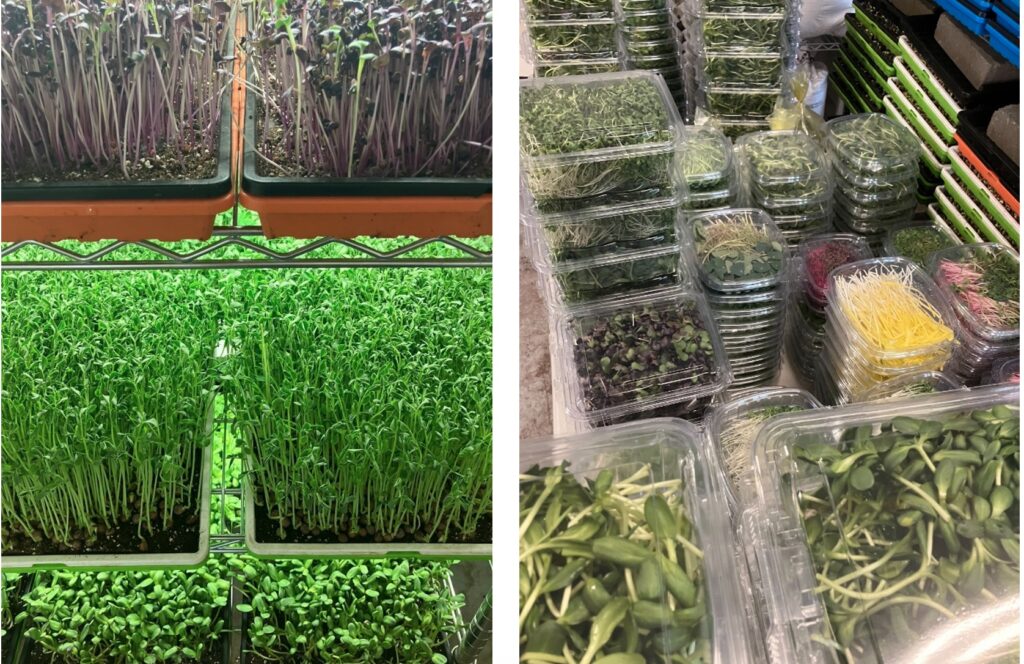
If you prefer not to cultivate your own microgreens, there may be some commercial options for Alaska-grown products in your local area.
A few commercial farmers in Alaska are supplying their products to both restaurants and retail markets. This growing trend provides local chefs and health-conscious consumers with fresh, nutrient-dense greens year-round. As more people become aware of the taste and health benefits of microgreens, demand is expected to increase, which will help bolster Alaskan agriculture.
Ken Hoffman and his wife, Alexandria, own and operate Mat-Su Microgreens in Palmer. They have been cultivating microgreens since 2022. Their original offerings, which remain popular, include sunflower, pea, radish, and broccoli. Sunflower shoots are crunchy and juicy, making them a great base for salads. Pea shoots are tender and have a sweet taste reminiscent of sugar snap peas. The radish varieties provide a bold, spicy kick along with a crisp texture. Broccoli microgreens, one of their most popular offerings, have a mild flavor like their mature counterparts.

Hoffman explained that “the reason broccoli is so popular is that studies have shown their microgreens to be 40 times more nutrient-dense than a head of broccoli. They do not have a strong flavor and it is a great way to boost the nutrient value of what you eat.”
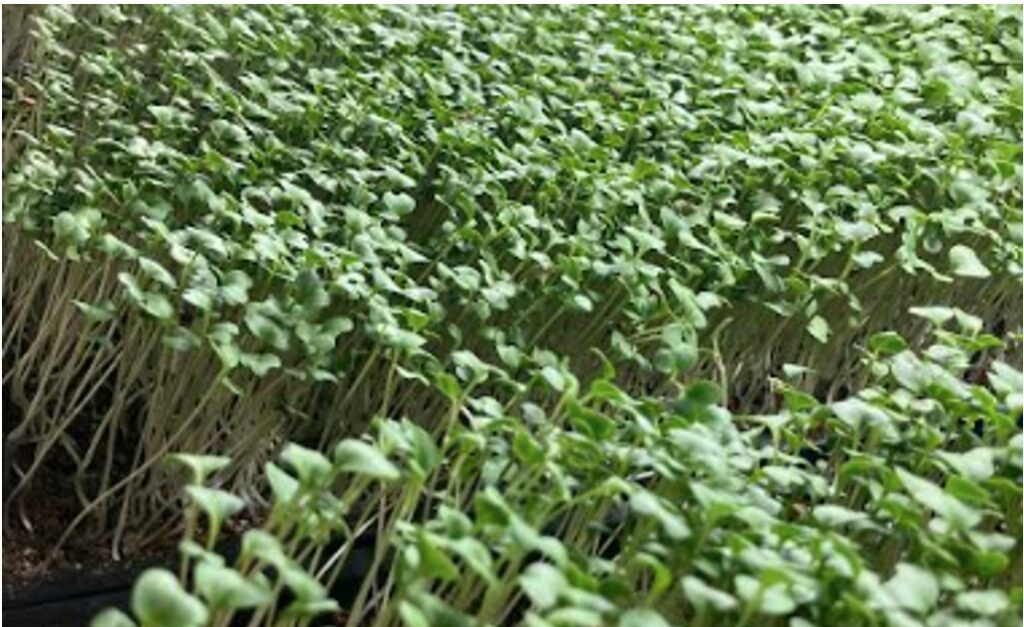
Mat-Su Microgreens has expanded its current offerings to include a full complement of microgreens, micro herbs, edible flowers, and wheatgrass. They sell the products through a subscription service directly to consumers seeking flavorful options for their home meals. They also supply several restaurants with fresh microgreens, providing weekly deliveries to establishments in Anchorage and Girdwood.
The farm’s potential for future growth is promising. Mat-Su Microgreens recently passed the USDA Harmonized GAP Audit, which will enable them to work with third-party distributors. This opens up opportunities for their products to be delivered to institutions and made available in grocery stores.
Hoffman believes there is a lot of room for expansion in the market for microgreens. He is optimistic that as awareness increases, more local farmers will consider this opportunity, which could lead to a sustainable source of year-round fresh produce. This shift could not only improve the nutritional options available in communities throughout Alaska but also support local agriculture and stimulate economic growth.
In addition to being a farmer, Ken Hoffman serves as the Executive Director of the Mat-Su Chapter of the Alaska Farm Bureau and hosts Ag Matters on Big Cabbage Radio. He shares his insights on the potential of Alaskan agriculture, based on his experience. He states, “We live in a global economy and rely on shipping of inputs from the Lower 48 for Alaska’s agricultural industry. The reality is geographical specialization: every region has its own specialties that they can produce. Even California is trading with Iowa to supplement their food supply.”
Hoffman explains that to produce microgreens, he obtains the necessary supplies, including the soil, growing trays, seeds, and containers, from suppliers in the lower 48. He then uses those inputs to produce fresh, locally grown, and healthy products. By following this approach, farmers and home gardeners across Alaska, even in remote areas, can access these inputs to more sustainably meet nutritional needs in their communities.
Several online suppliers, including Johnny’s Seeds, sell the essential supplies needed to begin growing microgreens. If you are located within their delivery area, Mat-Su Microgreens even offers a microgreens grow kit on their website that can be delivered to your home.
If you are interested in learning more about commercially farming microgreens to help boost Alaska’s well-being “one tiny green at a time”, you may contact Ken Hoffman directly via email at Matsufarmbureau @ gmail.com.
Microgreens complete the flavor profile of the Spruce-Tipped Salmon Ceviche recipe below, elevating this ceviche variation. This adaptation showcases the distinctive flavors of our region, featuring spruce tips and the umami qualities of kelp seasoning. Serving this wild-caught salmon dish with locally grown microgreens and thin, crispy crackers made from barley flour grown and milled in Delta Junction captures the essence of an authentic Alaska-inspired experience.

Spruce-Tipped Salmon Ceviche
Ingredients:
1 pound of salmon, skin and bones removed, diced into ½-inch pieces
½ teaspoon of salt
1 teaspoon of kelp (or dulce) seasoning
1 to 2 cloves of garlic, finely minced
1 cup of fresh lemon or lime juice
1 red bell pepper, cut into small slices
1 to 2 jalapeño peppers, finely diced
1 red chili pepper, finely diced
1 small red onion, thinly sliced
¼ cup spruce tips
1 large avocado, or 2 small ones
1 ounce of your favorite variety of microgreens
Makes approximately 6 servings.
Preparation:
Prepare the citrus marinade by combining the juice and minced garlic in a large non-reactive bowl (glass or ceramic). Next, sprinkle the diced salmon with salt and kelp seasoning. Add the seasoned salmon to the bowl with the citrus juice and minced garlic, then refrigerate for at least 45 minutes to an hour while you prepare the other ingredients.
Cut up the fresh vegetables by slicing the red bell pepper, finely dicing the jalapeño and chili peppers, and cutting the red onion into very thin slices. Next, separate the spruce tip needles, discarding the branch portion that connects them.
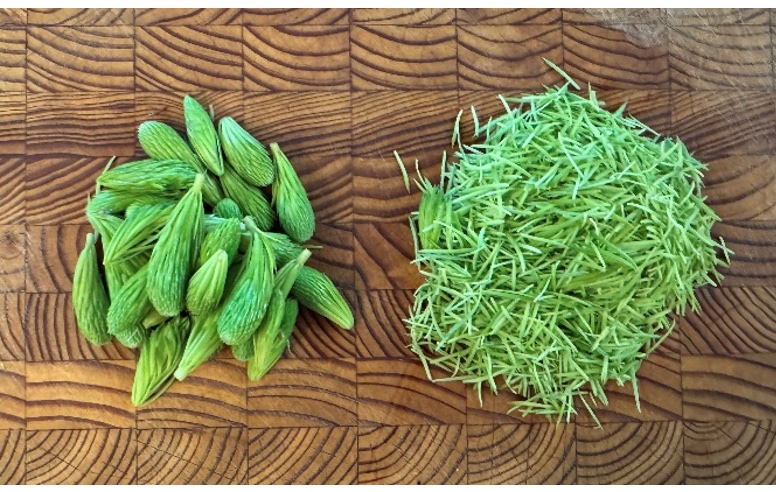
Wait to cut the avocado until the salmon has nearly finished marinating. The salmon needs time in the citrus juice to undergo a denaturation process. This process changes the texture of the salmon, making it resemble cooked salmon while preserving its fresh flavor without the use of heat.
When the salmon has marinated for the appropriate amount of time and has developed an opaque texture, drain the citrus marinade into a separate bowl and set it aside while you slice the avocado. To maintain the freshness of the sliced avocados, place them in the citrus marinade. Gently toss the avocado slices in the marinade to ensure they are evenly coated.
Finally, add the marinade containing the avocado back to the large mixing bowl with the salmon. Combine the peppers, sliced red onion, and spruce tips, then gently mix all the ingredients together.
When it’s time to serve the ceviche, transfer it to a single-serving dish and finish it with a generous portion of microgreens on top, accompanied by Alaska barley crackers.
Enjoy this refreshing cold dish as an appetizer or light summer meal.
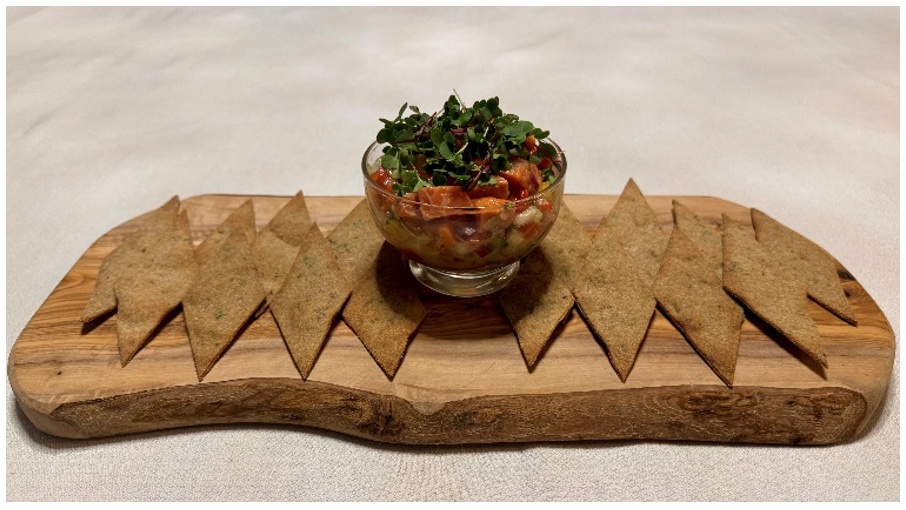
Alaska barley crackers are a perfect complement to the salmon ceviche and are simple to prepare, requiring only barley flour, salt, olive oil, and water. You can also add your favorite herb for extra flavor. Serving these crackers alongside the ceviche introduces a nutritious grain that is rich in both soluble and insoluble beta-glucan fiber. This combination of barley crackers, salmon ceviche, and microgreens provides a delicious way to enjoy essential nutrients while savoring the freshest, regionally sourced ingredients.

Alaska Barley Crackers
Ingredients:
3 cups Alaska barley flour, from Alaska Flour Company
½ cup, more or less, additional flour for rolling out the dough
1 to 2 teaspoons of salt
1 to 2 tablespoons of your favorite herb (optional)
4 tablespoons of olive oil
1 cup of water
This recipe yields roughly 45 to 65 crackers, depending on their size and thickness.
Preparation:
Preheat oven to 400.
Combine all the flour, salt, and herbs in your mixer. Next, create a well in the center of the dry mixture and pour in the oil and water. Use the mixer’s dough hook to thoroughly incorporate all ingredients together. The dough will be sticky.
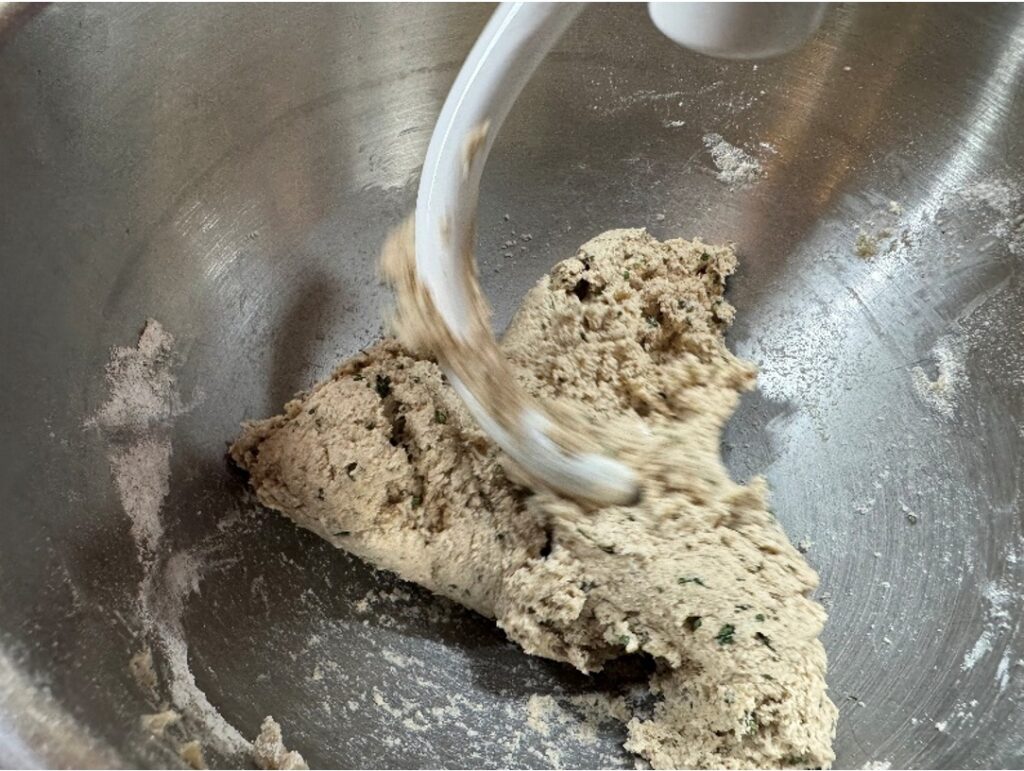
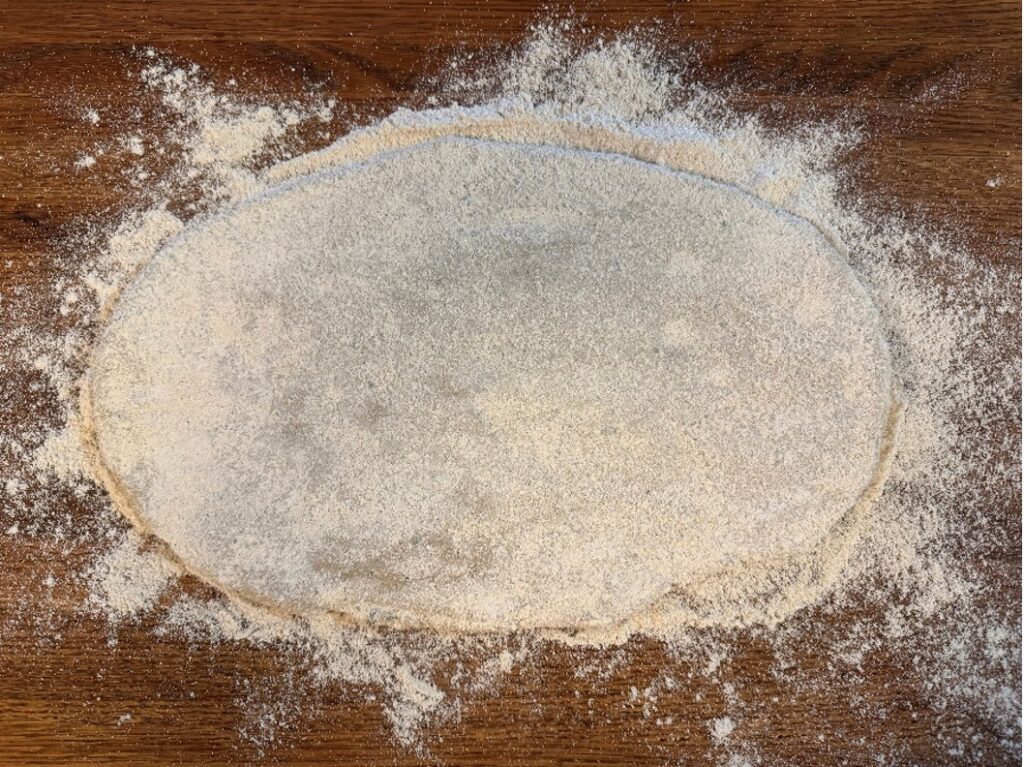
Sprinkle some flour on the surface where you will roll out the dough. Place the dough on the rolling board and sprinkle more flour on top.
Carefully roll out the dough with a rolling pin until it is very thin, approximately 1/8-inch thick. Use a long metal spatula to carefully slide between the dough and counter surface if it begins to stick. The thinner the crackers, the tastier and crispier they will be. This step becomes easier with practice. You may find it easier to split the dough into two portions and roll them out separately.
Cut the dough to create the shape of your crackers. You can choose any size and shape based on how you intend to use the crackers. The picture below shows the crackers cut on an angle to create diamond shapes.
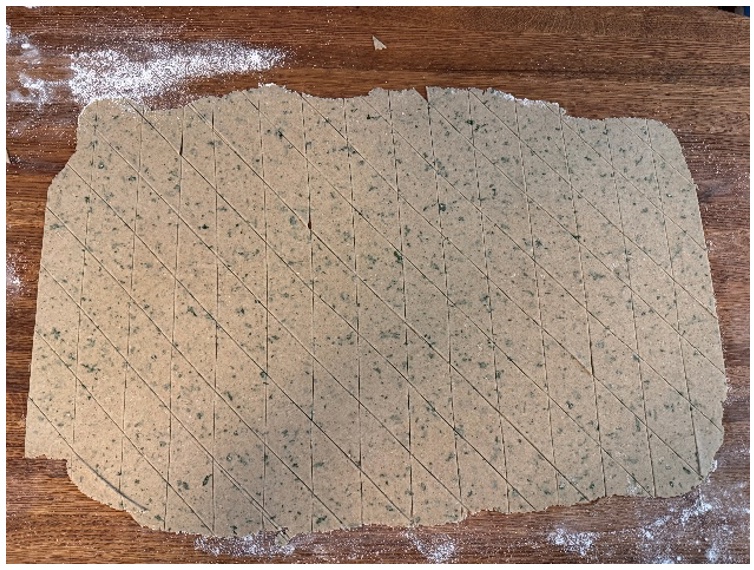
Using a metal spatula, carefully lift the cut dough a few crackers at a time and place them on a large sheet pan lined with parchment paper. Once the sheet pan is filled, repeat the process with the remaining dough. Make sure to leave some space between each cracker to allow for expansion during baking.
Bake for 12 to 15 minutes, or until the crackers begin to turn golden brown. Remove them from the oven and allow them to cool for 2 to 3 minutes before transferring them off the sheet pan.
After the crackers have completely cooled, place them in an airtight container or resealable zipper bag for storage.
Enjoy these light and crispy crackers.
Brenda Josephson is a Haines resident. She holds degrees in Culinary Arts and Food Business Leadership from the Culinary Institute of America, Hyde Park, New York. She enjoys spending time fishing, foraging, and savoring Alaska’s abundance of natural and wild foods with her family. You can contact her by email at [email protected].
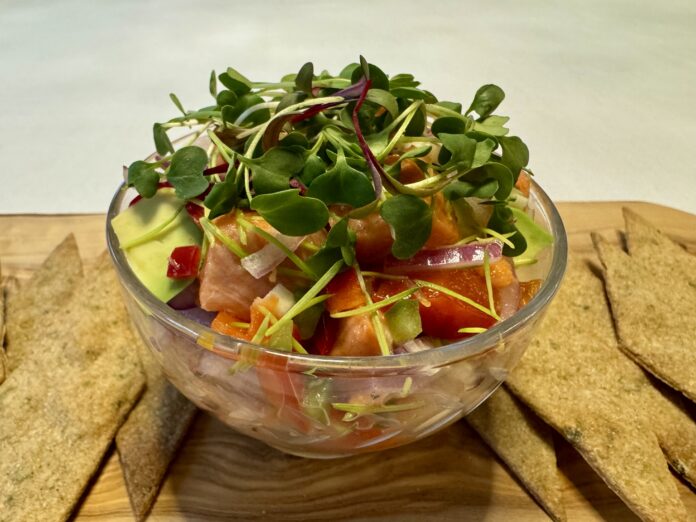
Oatmeal, fish, spam, Sailor Boy crackers, pop, coffee.
A balanced diet.